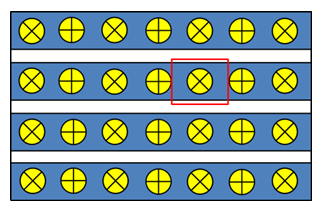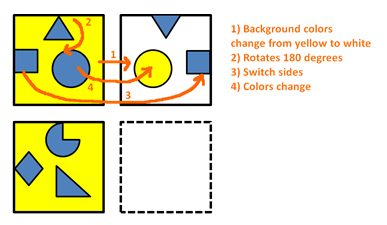Why Use Sample Questions to Help You Understand the NNAT Test?
Understanding the NNAT (Naglieri Nonverbal Ability Test) before test day is crucial for your child's success. Unlike traditional academic tests that measure what your child has learned in school, the NNAT evaluates your child's cognitive ability - their natural capacity to learn, reason, and solve problems. These aren't questions about math facts or reading comprehension; they're designed to reveal how your child's mind processes visual information and recognizes patterns, making sample questions essential for preparation.
NNAT Sample Questions Explained
Before you take the NNAT Test you need to know what type of test it is. The NNAT sample questions show four types of thinking tested in NNAT levels A-D. These questions are related because they all test nonverbal reasoning. Students need to look at pictures, find patterns, and think logically without using words or things they already know.
Each type of question uses basic thinking skills but focuses on different parts of visual and abstract reasoning. The questions get harder, starting with simple patterns and moving to more complex spatial problems. Together, these questions thoroughly test a student's nonverbal thinking skills in different ways.
Sample NNAT Questions by Type and Grade Level
Let's explore a sample question for each of the four NNAT test practice question types. We will break each question type down by grade level and show you examples.
NNAT Sample Questions Level A
The NNAT Level A targets kindergarten students and includes two question types: Pattern Completion and Reasoning by Analogy. These questions assess foundational nonverbal reasoning skills essential for gifted program admission.
In this type of NNAT test question, you need to identify the missing piece that completes a given pattern. Notice how the pattern alternates between shapes and colors, following a logical sequence.
Level A Pattern Completion
NNAT Sample Question 1
What is Missing ?
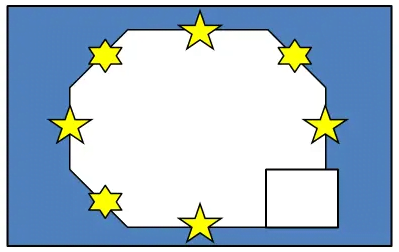
TestPrep-Online Tutor's Tip:
"I look at the pattern around the shape and see what is missing. I imagine the piece that would fit the empty spot by matching the colors and shapes around it. Look at the shapes and colors carefully, then find the answer that fits just right!"
Want More NNAT Test Prep Questions?
TestPrep-Online's complete NNAT Preparation Packs include
Full-length Tests, Quizzes and NNAT Video Academy from $69
Level A Reasoning by Analogy
Reasoning by Analogy involves a more complex relationship than Pattern Completion, often requiring you to compare and contrast different sets of figures to find the connection.
NNAT Sample Question 2
Apply Logic
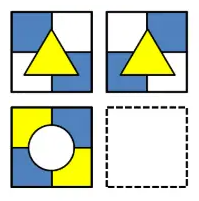
TestPrep-Online Tutor's Tip:
"I look at how the shapes and colors change from the top row to the bottom row. I ask myself, "What stayed the same, and what changed?" Then I use that pattern to figure out what the missing picture should look like. Try to match the shape and color changes!"
These NNAT sample questions require you to understand the relationship between figures and apply that relationship to a new set of figures.Notice how the pattern alternates between shapes and colors, following a logical sequence. These are the skills that are tested in order to be admitted to gifted and talented programs in schools. The test taker must recognize a rule or sequence that governs the arrangement of elements.
NNAT Sample Questions Level B
The NNAT (Naglieri Nonverbal Ability Test) Level B is designed for 1st-grade students and includes three types of questions: Pattern Completion, Reasoning by Analogy, and Serial Reasoning. Let's define each of these question types:
Level B Pattern Completion
Pattern Completion questions on the NNAT Level B assess a child's ability to identify and complete visual patterns and sequences1. In these questions they must analyze the existing parts of the design and understand how they relate to each other. This type of question challenges young learners to think critically and recognize relationships between visual elements
NNAT Sample Question 3
Which answer choice completes the design?
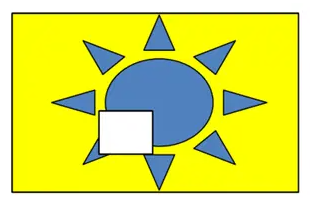
TestPrep-Online Tutor's Tip:
"When I help students with a puzzle like this, I say: “Pretend you're putting a piece back into a puzzle. Look at the shapes and colors that touch the missing square—see how the blue oval curves and where the yellow triangles point. Now find the piece that fits those same lines and colors.”
🟨➡️ Look for the curve of the blue and the tip of the triangle—that’s your clue!"
Level B Reasoning by Analogy
Reasoning by Analogy questions on the NNAT Level B test a student's ability to recognize relationships between geometric shapes and apply them to new situations
NNAT Sample Question 4
Choose the shape that matches the pattern of the given matrix.
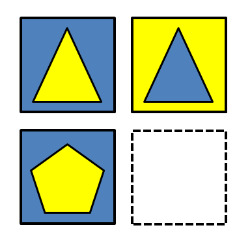
TestPrep-Online Tutor's Tip:
"Here’s what I tell my students: “Look across the top row—what changes? The shape stays the same, but the background color flips! Now look at the bottom row. The shape is a pentagon, so do the same thing—flip the background color!"
Level B Serial Reasoning
Serial Reasoning is a new category of questions introduced in Level B that students completing Level A have not yet encountered. In these questions students are presented with a series of visual elements or shapes that undergo gradual transformations. They must recognize sequences created by shapes and figures. The task is to identify how the sequence changes visually to form logical patterns.
NNAT Sample Question 5
Recognize and Continue Sequences or Patterns
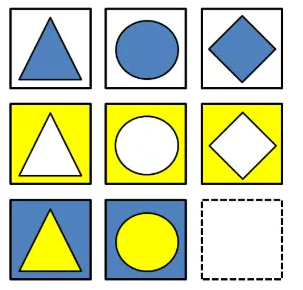
TestPrep-Online Tutor's Tip:
"Here’s how I’d help a student: “Look at the shapes in each column—they stay the same from top to bottom! The first column is triangles, the second is circles, and the third is diamonds. So what shape comes next? A diamond! Now match the background colors from the row.”
🟨🟦🟨 = Follow the pattern, and you’ll crack the code!"
Transitioning from Free to Full NNAT Practice Tests
While our free NNAT 3 practice test samples provide a great starting point, comprehensive preparation is key to success on the NNAT. Our full NNAT prep packs offer:
Full-length NNAT practice tests
Detailed explanations for each question
Progress tracking and performance analysis
Ready to take your child's NNAT preparation to the next level?
NNAT Sample Questions Level C
The NNAT (Naglieri Nonverbal Ability Test) Level C, designed for 2nd-grade students, includes four types of questions: Pattern Completion, Reasoning by Analogy, Serial Reasoning, and Spatial Visualization.
Level C Pattern Completion
These questions are more complex than in previous levels, challenging students to think critically and recognize relationships between visual elements
These questions test your child's ability to mentally manipulate shapes and understand spatial relationships.Notice how the shapes are rotated or flipped to create the final figure.
NNAT Sample Question 6
Which answer choice completes the pattern?
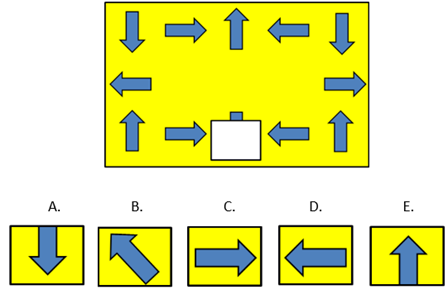
TestPrep-Online Tutor's Tip:
"Look at the arrows and see how they are moving around the box. Imagine what the next arrow in the pattern should be. Which way does it point?"
Level C Reasoning by Analogy
Reasoning by Analogy questions on the NNAT Level C test a student's ability to recognize and apply analogical relationships among visual elements and shapes.
NNAT Sample Question 7
Choose the shape that matches the pattern of the given matrix.
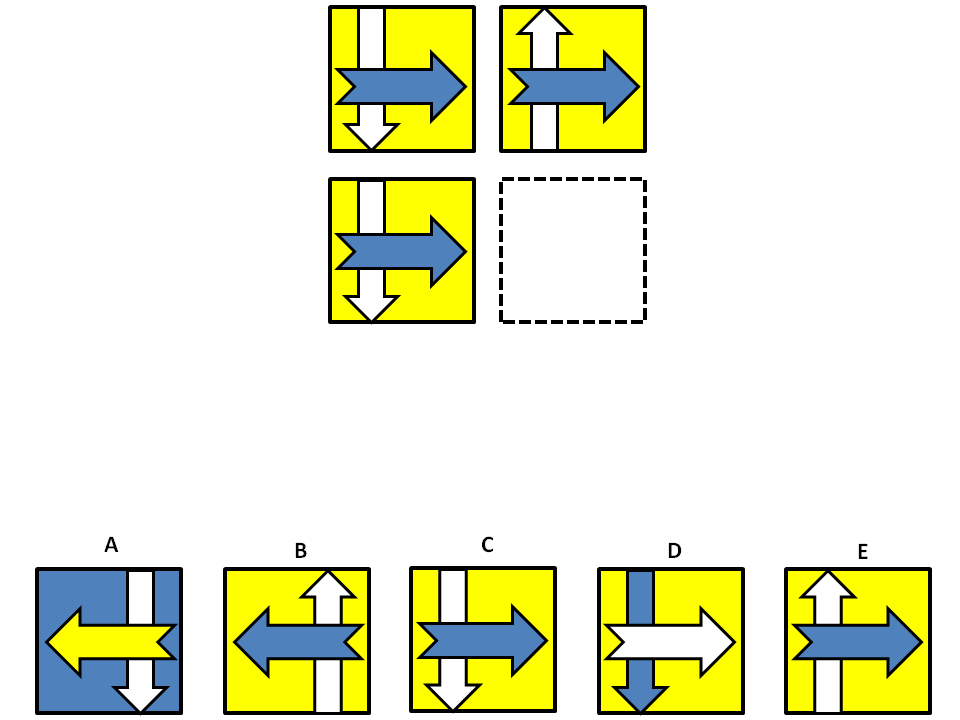
TestPrep-Online Tutor's Tip:
"Look at the first two boxes and see what changes from one to the next. Does anything flip or move? Now, apply that same change to the third box to find your answer."
Level C Serial Reasoning
Reasoning by Analogy questions on the NNAT Level C test a student's ability to recognize and apply analogical relationships among visual elements and shapes.The task involves understanding how shapes change across rows and columns in a matrix.
NNAT Sample Question 8
How are the images changing
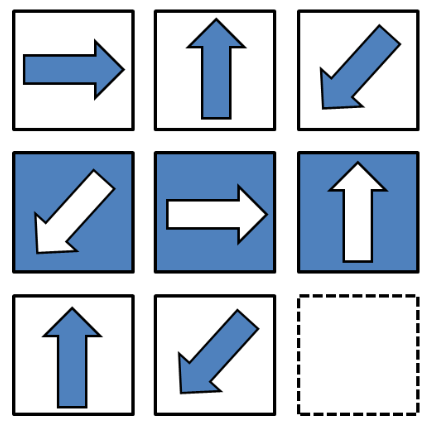
TestPrep-Online Tutor's Tip:
"Look closely at how the arrows are moving and changing color. Can you see a pattern in each row and column? Try to figure out what happens when the arrows move from one box to the next, both across and down, to find the missing piece!"
Level C Spatial Visualization
Spatial Visualization questions are introduced in NNAT Level C and require students to mentally manipulate shapes. They ask students to visualize how objects might look when rotated, transformed, or combined.
NNAT Sample Question 9
Mentally Manipulate and Visualize Transformations
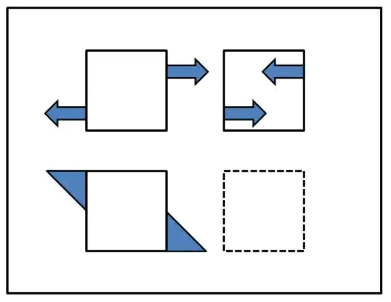
TestPrep-Online Tutor's Tip:
"Imagine you're building with blocks! Look at the first two shapes and see how they change to become the third. Are they flipping, sliding, or turning? Now, take that same 'building rule' and apply it to the last shape to find what comes next. Try to see it in your mind before you even look at the answers!"
NNAT Sample Questions Level D
The NNAT (Naglieri Nonverbal Ability Test) Level D is designed for 3rd and 4th-grade students and includes four types of questions: Pattern Completion, Reasoning by Analogy, Serial Reasoning, and Spatial Visualization.
Level D Pattern Completion
These questions in Level D challenge students to think critically and recognize relationships between visual elements.
NNAT Sample Question 10
What image is missing
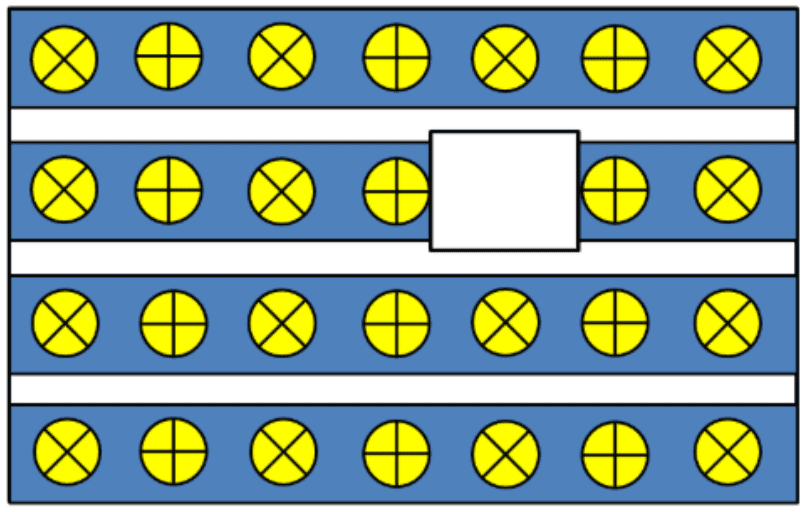
TestPrep-Online Tutor's Tip:
"Look at the rows and columns. Can you spot a pattern in how the circles and X's are arranged? Sometimes things repeat, or they might change in a special order. Once you find the pattern, you'll know exactly what should go in the empty spot!"
Level D Reasoning by Analogy
Reasoning by Analogy questions on the NNAT Level D test a student's ability to recognize and apply analogical relationships among visual elements and shapes.
NNAT Sample Question 11
Note the changes
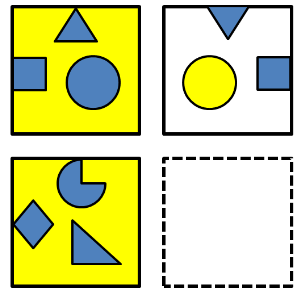
TestPrep-Online Tutor's Tip:
"Imagine each row and column is telling a little story about how the shapes are turning or flipping. Can you 'read' the story in the first two rows and columns? Whatever happens to the shape in those stories, make it happen to the last shape to find the perfect ending for the empty box!"
Level D Serial Reasoning
Serial Reasoning questions on the NNAT Level D assess a student's ability to recognize sequences and patterns in a series of figures. They are usually in a 3X3 grid.
NNAT Sample Question 12
Visualize the analogous relationship
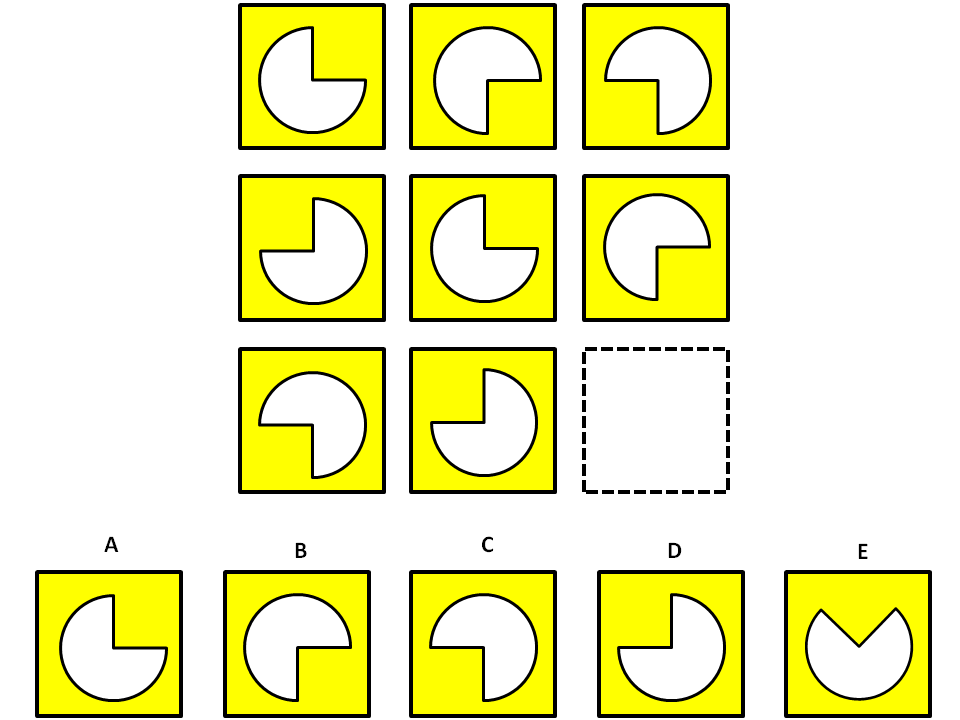
TestPrep-Online Tutor's Tip:
"Imagine each row and column is telling a little story about how the shapes are turning or flipping. Can you 'read' the story in the first two rows and columns? Whatever happens to the shape in those stories, make it happen to the last shape to find the perfect ending for the empty box!"
Level D Spatial Visualization
Spatial Visualization questions on the NNAT Level D require students to manipulate shapes and mentally understand spatial relationships. It requires students to determine how figures relate to each other and apply this relationship to a row with an empty frame.
NNAT Sample Question 13
Sharing the same relation
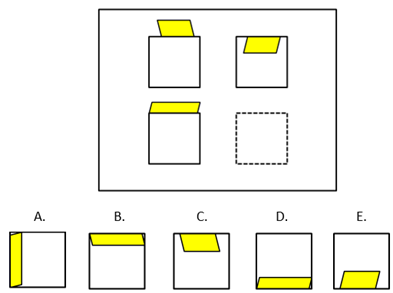
TestPrep-Online Tutor's Tip:
"Imagine these shapes are playing a game of 'follow the leader'! Look at the first two boxes and figure out exactly what the yellow shape does. Does it slide? Does it flip? Does it turn? Once you've cracked the code of their movement, apply that exact same move to the third box. The answer will be the one that perfectly follows the leader's rule!"
Analyzing Your Performance on Free NNAT Sample Questions
After completing the free NNAT sample questions, take time to analyze your child's performance:
- Which question types were most challenging?
- How long did it take to complete each NNAT test practice question?
- Were there any patterns in the incorrect answers?
- Use these insights to guide your further preparation efforts.
- Boost your NNAT scores.
Additional Free NNAT Practice Tests
To further support your child's NNAT preparation, we offer free practice pages for different NNAT levels:
Why Choose Our Naglieri Nonverbal Ability Test Prep Materials?
Our NNAT3 preparation resources are:
- Developed by experts in gifted education
- Regularly updated to reflect the latest test format
- Designed to engage and challenge young minds
- Proven effective by thousands of satisfied parents and students
Naglieri Nonverbal Ability Test Resources for All Age Groups
Whether your child is in kindergarten or high school, we have NNAT prep materials tailored to their specific level and needs. Our resources cover 4 NNAT levels (A through D), ensuring comprehensive preparation for early access to gifted test prep.
Prep Smarter, Not Harder
One membership. Three children. 12 months. Complete test prep success.
Family Membership Plan
How to Use These Free NNAT Sample Questions Effectively
To make the most of our free NNAT sample questions, follow these tips:
- Create a quiet, distraction-free environment similar to the actual test setting.
- Time your child's practice sessions to simulate test conditions.
- Encourage your child to explain their reasoning for each NNAT3 answer.
- Review incorrect answers together to understand areas that need more focus.
Want More NNAT Questions?
Double the practice, double the confidence! Get our OLSAT & NNAT Bundle for more ways to master abstract reasoning skills - all in one affordable package.
Smart Parents Choose Both Tests - Here's Why:
- Similar Skills, Double the Practice: Since OLSAT & NNAT test similar thinking patterns, practicing both helps reinforce key concepts in different ways
- More Fun, Less Pressure: Mix and match questions from both tests to keep practice sessions fresh and engaging
- Incredible Value: Access both complete test prep packages for less than buying separately
Start Your NNAT Journey Today
Don't let the Naglieri Nonverbal Ability Test intimidate your gifted child. With the right NNAT practice test, they can showcase their true potential and open doors to advanced educational opportunities. Ready to give your child the best chance of success on the NNAT?
Remember, effective preparation is the key to confidence and success on test day. Start your child's NNAT journey with our free NNAT Sample questions, and when you're ready for more in-depth practice, our full NNAT practice tests are just a click away. Give your gifted child the tools they need to shine on the NNAT!
NNAT FAQs
NNAT questions don't test what your child has memorized in school - they test cognitive ability. Instead of math problems or reading comprehension, your child will analyze visual patterns, complete sequences, and manipulate shapes mentally. These questions reveal your child's natural problem-solving capacity and learning potential.
While you can't "study" traditional academic content for the NNAT, you absolutely can prepare! Practice with sample questions helps your child become familiar with the visual format, question types, and thinking patterns required. This preparation builds confidence and improves performance by reducing test anxiety and increasing familiarity with nonverbal reasoning tasks.
NNAT levels correspond to grade levels:
Kindergarten students should practice Level A
1st graders should use Level B materials
2nd graders need Level C preparation
3rd and 4th graders should focus on Level D
Our free sample questions provide an excellent introduction to the NNAT format and question types. However, comprehensive preparation requires extensive practice with hundreds of questions, full-length tests, and detailed explanations
Don't worry! NNAT questions are designed to be challenging since they test advanced cognitive abilities. If your child finds the sample questions difficult, this indicates they need more practice with nonverbal reasoning skills. Our comprehensive prep packs provide the extensive practice and explanations needed to build these abilities.
Yes! Parents play a crucial role in NNAT preparation by providing a quiet practice environment, encouraging their child, and helping them understand question types through our detailed explanations. Our "Teacher Says" sections are specifically designed to help parents guide their children through the reasoning process.

